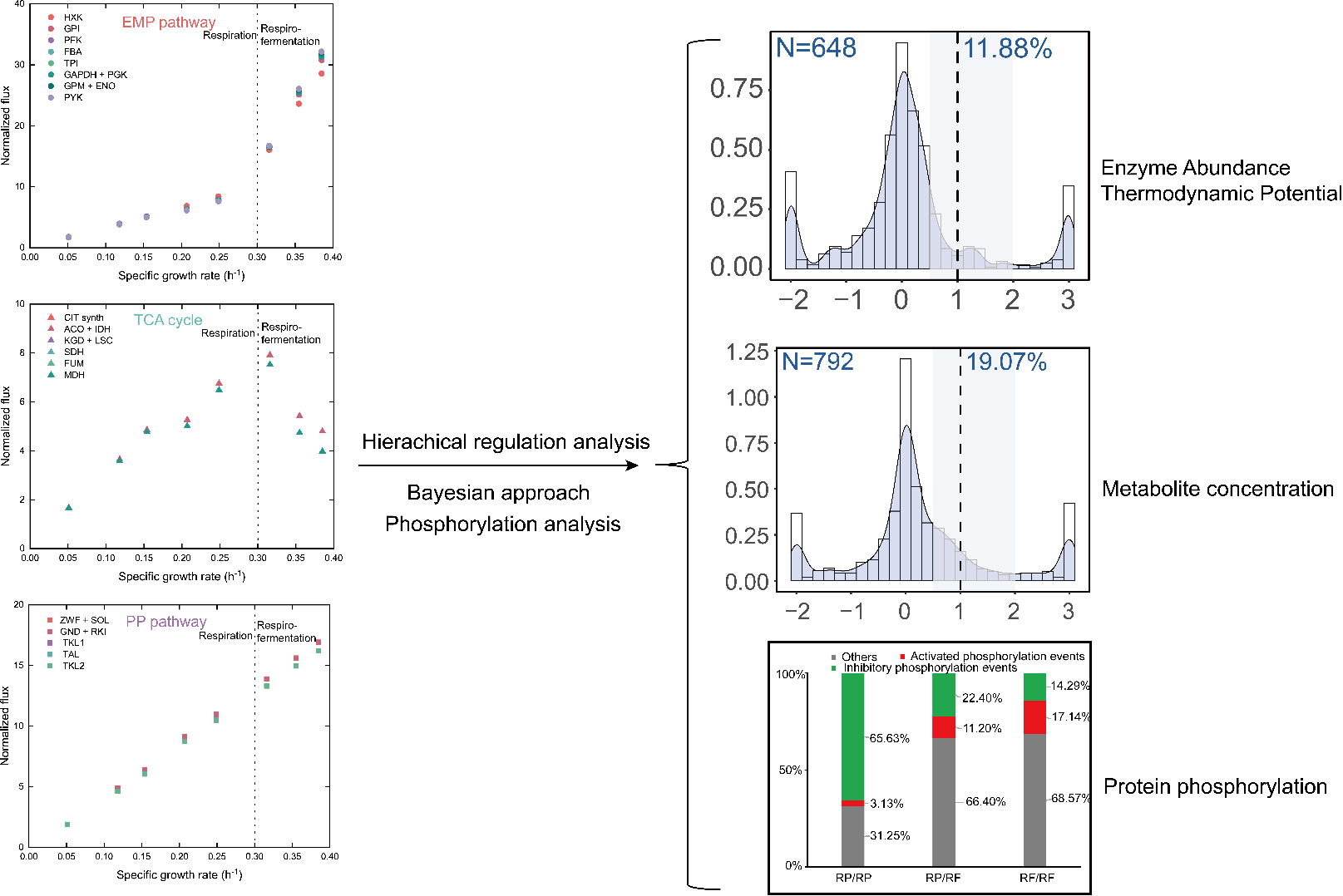Metabolic reaction flux change is the final result of interacting regulations by intracellular gene expression, transcriptional regulation, protein level, translation modification, and allosteric effect, etc. However, the regulatory mechanism of metabolic flux changes is still not very clear: for example, how much flux changes can be explained by gene expression level and how much is regulated by the enzyme activity are still unknown. In addition, for the central carbon metabolic pathway, the contribution proportion of two important regulatory factors (protein phosphorylation, and the allosteric effects of metabolites) to flux changes have not been quantified. Furthermore, the metabolic regulatory mechanism behind the Crabtree effect of Saccharomyces cerevisiae is still not fully understood. For example, the regulatory factors that mainly contribute to the metabolic flux changes through the central carbon metabolic pathway under aerobic respiration and aerobic fermentation conditions have not been reported.
In a recent study published in PNAS, the team of XIA Jianye from the Intelligent Biomanufacturing Center at Tianjin Institute of Industrial Biotechnology, Chinese Academy of Sciences (CAS), the team of ZHUANG Yingping from the State Key Laboratory of Bioreactor Engineering at East China University of Science and Technology, and the team of Jens Nielsen from the Chalmers University of Technology cooperated to develop a method to identify allosteric effectors that have physiological reaction flux regulation functions. The proportion of each regulatory factor (protein abundance, thermodynamic potential, substrate concentration, allosteric effector concentration, and protein phosphorylation) contributing to flux changes was quantified.
Flux distribution of the central carbon metabolic pathway of Saccharomyces cerevisiae under aerobic respiration and aerobic fermentation conditions was obtained by 13C isotopically labeled metabolic flux analysis. Then, hierarchical regulatory analysis was used to quantify the contributed proportion of protein abundance and thermodynamic potentials to flux changes (about 12%). Subsequently, the Bayesian inference approach was used to identify the allosteric effectors that have reaction flux regulation functions. In addition, contributions of these physiologically relevant allosteric effectors combined with the substrates to reaction flux changes are quantified (about 19%). Finally, the protein phosphorylation analysis result shows that protein phosphorylation plays a key role in regulating the flux of the glycolytic pathway in Saccharomyces cerevisiae.
These results reveal the regulatory patterns of metabolic flux changes in the central carbon metabolic pathway of Saccharomyces cerevisiae under both aerobic respiration and aerobic fermentation conditions and also indicate that a large number of unknown regulatory factors need to be further investigated. In addition, the method used in this study has high universality and can be adapted to be used in the study of metabolic flux regulation mechanisms in other strains.
This work was financially supported by the National Natural Science Foundation of China (No. 21776082) and the Knut and Alice Wallenberg Foundation. CHEN Min, visiting Ph.D. student at Tianjin Institute of Industrial Biotechnology, CAS, is the first author of the paper. XIA Jianye, Principle Investigator at Tianjin Institute of Industrial Biology, CAS, and Professor Jens Nielsen, Chalmers University of Technology, are the corresponding authors.

The proportion of each metabolic regulatory factor contributing to flux changes through the central carbon metabolic pathway in aerobic respiration and aerobic fermentation of Saccharomyces cerevisiae (Image by TIBCAS)
Contact:
Prof. XIA Jianye
Tianjin Institute of Industrial Biotechnology, Chinese Academy of Sciences.
Email: xiajy@tib.cas.cn